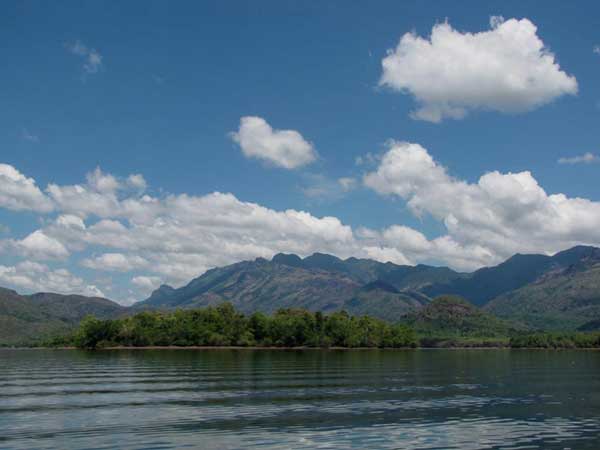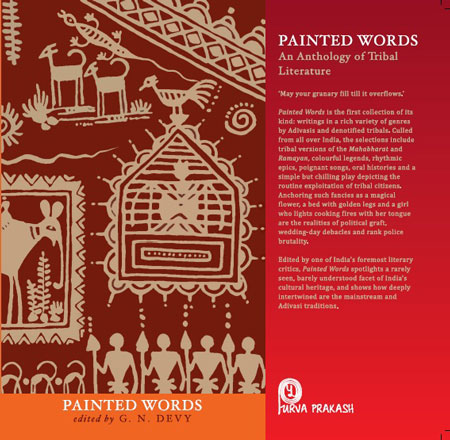
Photo courtesy Davidson Sargunam >>
Renowned writer and social activist Mahasweta Devi termed Adivasis as “the most civilised people” to whom Indian forests, rivers and mountains owe their survival.
She praised their egalitarian social structure where nobody is greater than anybody, and where social evils such as dowry do not exist.
Addressing students at the University of Hyderabad here on Monday, she attributed whatever natural balance left to survive in India to the presence of Adivasis. […]
She also reminisced her days in Shantinikethan, and how she embarked on her first work ‘Jhansir Rani’. […]
The interactive session was organised by the Centre for Dalit and Adivasi Studies and Translation, University of Hyderabad.
Source: “Adivasis most civilised people”, The Hindu, 2 October 2012
Address : https://www.thehindu.com/news/cities/Hyderabad/‘Adivasis-most-civilised-people’/article12542421.ece
Date Visited: 11 April 2021

“The forest in Shanthi Teacher’s classroom” on Ruralindiaonline.org >>
More about Tribal elders & Women >>
Success stories >>
“National development and the development of tribal communities are linked to each other” – Droupadi Murmu | Learn more >>
“Tribal communities are a standing example of how women play a major role in preservation of eco historic cultural heritage in India.” – Mari Marcel Thekaekara (writer and Co-Founder of ACCORD-Nilgiris) | Learn more >>
“When you are leaving 60 percent of the people behind, you cannot have the ambition to be an economic power.” – Poonam Muttreja (Executive Director of the Population Foundation of India) >>
“Women and girls are disproportionately affected by modern slavery. As they transition through childhood, adolescence and adult life, the impacts of discrimination multiply and gender inequality grows.” – Walk Free Foundation | Learn more >>
“There is no social bias against women in tribal communities such as there exists among the middle castes, especially landed ones. Women can ask for a divorce, and in many communities, money is paid to the girl’s family at the time of marriage.” – Abhay Bang, the award-winning doctor and social activist from Gadchiroli in Maharashtra | Learn more >>
Wildlife conservationist Ramesh in “Bomman thatha and his forest”, a conversation with his grandfather on “bonding between adivasi people and the forest” | Read the full story >>
My name is Ramesh. I work in The Shola Trust as a wildlife conservationist. In this blog, I am writing about my conversation with my grandfather, Bomman thatha (grandfather) about the bonding between adivasi people and the forest.
Bomman thatha is from the Bettakurumba tribe. He lives in the village, Kanjikolly, along the edge of Mudmalai and of course has a great knowledge about forest and honey collection, fishing, collecting tubers and medicinal plants.Bomman thatha told me that our gods live in stones, big rocks and trees. We won’t cut aal maram (Ficus religiosa) because gods will be in that tree. Even the water in the area around the tree should be used neatly and not destroyed. In our community our god Ajji (grandmother) lives in Ellamalai mountain. She is also called Thrithri Eributham. While going there we should not wear slippers and men should wear mundu above the knees. Women should also wear sari little bit below the knees. We should not spit or cut the cane there. There is a lot of vethalai (betel leaf) which we can eat but before eating we should wash our legs and hands and pray to god. […]
When we have to cut trees, we won’t cut all the trees; we will cut only what we need. There are a lot of dangerous trees also. There is one tree with very big leaves. If we touch that leaf, it feels like burning. […]
Bomman thatha also told me about the small honey bees that make combs on lantana sticks. The honey will be 100gm or 200 gram only. It is good quality honey and also the best medicine for cold.
I asked him about the way in which they collect tubers and fish. While collecting tubers, we take only what we need and we will cover the rest with mud again. Usually the main root is not taken because we need it for next year. […]
Before fishing or taking tubers, we will pray to god and only then we will take it. If we do not pray to god we won’t get anything. We don’t have boundaries for collecting tubers or fish but if people from one village are going to another village to collect anything from the forest, they will inform their relatives in that village and go only with them. […]
Deer and elephants are coming to our homes from the forest because of two things – one, they are afraid of tigers and leopards and second, there is no food for them in the forest. So we have to remove lantana and then burn it. After six months we should see how nicely the grass will grow. […]
Ramesh is from the Bettakurumba tribe. He works with The Shola Trust on Human-Elephant conflict.
Source: “Bomman thatha and his forest” by wildlife conservationist Ramesh, At the Edge of Existence, 29 October 2014
URL: https://cultureandconservation.wordpress.com/2014/10/29/bomman-thatha-and-his-forest
Date Visited: 8 August 2022
[Bold typeface added above for emphasis]
“The tribal world and the tribal way is complete in itself.” – Mahasweta Devi quoted by Gopalkrishna Gandhi in “Swearing by Mahasweta” (The Hindu, 6 August 2016)
Her notable works include Hajar Chaurashir Maa, Breast Stories, and Tin Korir Sadh, among many others. Several of her works have been adapted in films over the years. The leading Bengali fiction writer was known for her contribution towards the welfare of tribal people.
Source: “Eminent writer Mahasweta Devi dies at 90 in Kolkata” (Scroll.in, 28 July 2016)
URL: https://scroll.in/latest/811738/eminent-writer-mahasweta-devi-dies-at-90-in-kolkata
Date visited: 11 April 2021
“In his play Muktadhara (The Waterfall), Tagore robustly employs this element of freedom. The play relates the story of an exploited people and their eventual release from it. [Today, when] tribal populations across India are being uprooted with impudence Tagore’s message of freedom, in all its shades, is of utmost relevance.” – Bhaswati Ghosh in Freedom in Tagore’s Plays | Learn more >>
Find publications by reputed authors (add “open access” for freely downloadable content)
Tips for using interactive maps
Toggle to normal view (from reader view) should the interactive map not be displayed by your tablet, smartphone or pc browser
For details and hyperlinks click on the rectangular button (left on the map’s header)
Scroll and click on one of the markers for information of special interest
Explore India’s tribal cultural heritage with the help of another interactive map >>
See also
Adverse inclusion | Casteism | Rural poverty
Childhood | Tribal Children’s Right to Education in India
Demographic Status of Scheduled Tribe Population of India (Census figures 2011)
Fact checking | Figures, census and other statistics
Human Rights Commission (posts) | www.nhrc.nic.in (Government of India)
Search tips | Names of tribal communities, regions and states of India
“What is the Forest Rights Act about?” – Campaign for Survival and Dignity
“Who are Scheduled Tribes?” – Government of India (National Commission for Scheduled Tribes, NCST)

Tribal Literature by G.N. Devy >>
Free eBooks & Magazine: Adivasi literature and languages >>
“India, a union of states, is a Sovereign, Secular, Democratic Republic with a Parliamentary system of Government. The President is the constitutional head of Executive of the Union. In the states, the Governor, as the representative of the President, is the head of Executive. The system of government in states closely resembles that of the Union. There are 28 states and 8 Union territories in the country. Union Territories are administered by the President through an Administrator appointed by him/her. From the largest to the smallest, each State/UT of India has a unique demography, history and culture, dress, festivals, language etc. This section introduces you to the various States/UTs in the Country and urges you to explore their magnificent uniqueness…” – KnowIndia (Government), States and Union Territories (Visited: 2 September 2023)
Learn more about India’s 28 States and 8 Union Territories – From Andhra Pradesh to West Bengal | Nutrition >>